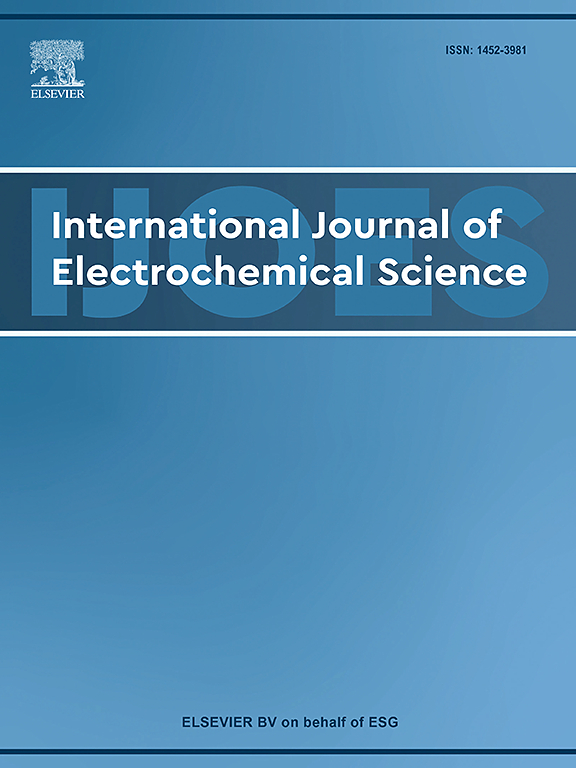金属氧化物、双金属纳米复合材料、金属有机框架(mof)和生物液体葡萄糖传感器的非侵入性技术的最新进展:综述
IF 2.4
4区 化学
Q4 ELECTROCHEMISTRY
International Journal of Electrochemical Science
Pub Date : 2025-09-18
DOI:10.1016/j.ijoes.2025.101184
引用次数: 0
摘要
用于糖尿病控制的葡萄糖生物传感器领域自20世纪60年代首次引入以来,经历了巨大的科学和技术发展,电化学生物传感器因其高精度、多功能性和与可穿戴设备的兼容性而成为实时、动态血糖监测的最有前途的平台。在过去的十年中,可穿戴医疗技术有了显著的进步,可以通过电化学传感对汗液、唾液、眼泪和间质液(ISF)等外周生物流体中的生物标志物进行无创或微创监测。虽然酶生物传感器,特别是那些使用葡萄糖氧化酶(GOx)的生物传感器,仍然因其敏感性而流行,但酶不稳定性和有限的保质期等挑战仍然存在。因此,非酶催化技术得到了突出的发展,利用纳米结构材料,如金属氧化物(如NiO、CuO、ZnO)、金属有机框架(MOFs)和双金属复合材料(如CuCo-MOFs)来实现卓越的灵敏度、稳定性和催化性能。这些材料利用高表面体积比、可调节的孔隙度和协同效应,克服了pH敏感性和导电性差等限制。材料设计方面的创新,包括激光诱导(LIG)和混合复合材料(如激光诱导)。, MXene/rGO),进一步增强了电子转移,这些材料具有低检测限,宽线性范围和快速响应时间。本文综述了最近的无酶葡萄糖传感器,重点介绍了纳米材料的进展及其与可穿戴平台的集成,如用于泪液分析的基于微针的ISF监测隐形眼镜传感器和用于汗液葡萄糖检测的水凝胶贴片。我们批判性地评估了生物流体传感的现状,解决了精度和可扩展性方面的挑战,同时强调了先进纳米材料的融合。本文章由计算机程序翻译,如有差异,请以英文原文为准。
Recent advances in metal oxide, bimetallic nanocomposites, metal-organic frameworks (MOFs), and non-invasive technologies for biofluid-based glucose sensors: A comprehensive review
The field of glucose biosensors for diabetes control has experienced enormous scientific and technological developments since it was first introduced in the 1960s, with electrochemical biosensors emerging as the most promising platform for real-time, dynamic glucose monitoring due to the high precision, versatility and compatibility with wearable devices. Over the past decade, wearable healthcare technologies have significantly advanced, enabling non-invasive or minimally invasive monitoring of biomarkers in peripheral biofluids such as sweat, saliva, tears and interstitial fluid (ISF) through electrochemical sensing. While enzymatic biosensors, particularly those employing glucose oxidase (GOx), remain prevalent for their sensitivity, challenges such as enzyme instability and limited shelf life persist. In response, non-enzymatic have gained prominence, leveraging nanostructure materials like metal oxides (e.g., NiO, CuO, ZnO), metal-organic frameworks (MOFs) and bimetallic composites (e.g., CuCo-MOFs) to achieve superior sensitivity, stability and catalytic performance. These materials exploit high surface-to-volume ratios, tuneable porosity and synergistic effects to overcome limitations such as pH sensitivity and poor conductivity. Innovations in material design, including laser-induced (LIG) and hybrid composites (eg., MXene/rGO), further enhance electron transfer and these materials enable low detection limits, wide linear ranges and rapid response time. This review comprehensively examines recent enzyme-free glucose sensors, focusing on the advancement of nanomaterials and their integration into wearable platforms such as microneedle-based ISF monitor contact lens sensors for tear analysis and hydrogel patches for sweat glucose detection. We critically evaluate the current state of biofluid sensing, addressing challenges in accuracy mad scalability while highlighting the convergence of advanced nanomaterials.
求助全文
通过发布文献求助,成功后即可免费获取论文全文。
去求助
来源期刊
CiteScore
3.00
自引率
20.00%
发文量
714
审稿时长
2.6 months
期刊介绍:
International Journal of Electrochemical Science is a peer-reviewed, open access journal that publishes original research articles, short communications as well as review articles in all areas of electrochemistry: Scope - Theoretical and Computational Electrochemistry - Processes on Electrodes - Electroanalytical Chemistry and Sensor Science - Corrosion - Electrochemical Energy Conversion and Storage - Electrochemical Engineering - Coatings - Electrochemical Synthesis - Bioelectrochemistry - Molecular Electrochemistry

 求助内容:
求助内容: 应助结果提醒方式:
应助结果提醒方式:


